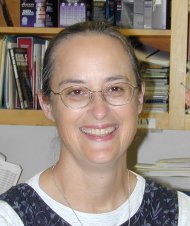Biological Science Faculty Member
Dr. Laura R. Keller
- Office: 211 Biomedical Research Facility
- Office: (850) 644-5780
- Lab: Biomedical Research Facility
- Lab: (850) 644-9814
- Fax: (850) 644-0481
- Mail code: 4370
- E-mail: lkeller@bio.fsu.edu

Associate Professor
Ph.D., University of Virginia, 1980
Research and Professional Interests:
Perception of environmental conditions and the initiation of appropriate responses are critical for survival of an organism. At the cellular level, extracellular signals that cause cells to change their behavior often require resetting the cell's program of gene transcription. In an increasing number of cases, it is possible to trace the route followed by a signal initiated at the cell surface to its transcription-factor targets. However, how a cell regulates the specificity of a response is less clear, given that the same signaling pathways can activate different sets of genes, and different signaling pathways can activate the same genes.
The flagellar regeneration system of the eukaryotic green alga Chlamydomonas reinhardtii is ideal for dissecting gene regulation in response to extracellular signals. Chlamydomonas cells have a pair of flagella used for swimming in fresh water. Certain extracellular stimuli lead cells to detach their flagellar pair, begin reassembly of a new pair of flagella, and also transiently to induce transcription of a large and specific set of RNA's encoding over 200 different flagellar proteins. The aim of research in my lab is to delineate the signaling pathways and mechanisms involved in the coordinate induction of flagellar RNA's of Chlamydomonas using cell biological, biochemical, microscopic, molecular, and genetic approaches.
Recent studies in the lab have implicated Ca2+ as a key common regulator of flagellar detachment, regrowth, and flagellar gene induction. Part of the current work in my lab is directed toward identifying elements of the intracellular Ca2+ signaling pathway leading to flagellar gene induction. Other work is directed toward defining DNA elements flanking the flagellar genes and the factors that interact with these elements, which regulate flagellar gene transcription.
Selected Publications:
Keller, L. R., and C. P. Emerson, Jr. 1980. Synthesis of adult myosin light chains by embryonic muscle cultures. Proc. Natl. Acad. Sci. USA 77: 1020-1024.
Keller, L. R., and C. P. Emerson, Jr. 1982. Development of fiber type specificity in embryonic avian muscles. Pages 836-875 in Diseases of the Motor Unit. D. L. Schotland, ed. Wiley, New York.
Keller, L. R., J. A. Schloss, C. D. Silflow, and J. L. Rosenbaum. 1984. Transcription of alpha and beta tubulin genes in vitro in isolated Chlamydomonas reinhardtii nuclei. J. Cell Biol. 98: 1138-1143.
Baker, E. J., L. R. Keller, J. A. Schloss, and J. L. Rosenbaum. 1986. Protein synthesis is required for the rapid degradation of tubulin mRNA and other deflagellation-induced RNAs in Chlamydomonas. Mol. Cell. Biol. 6: 54-61.
Morris, R. L., L. R. Keller, A. Zweidler, and P. J. Rizzo. 1990. Analysis of Chlamydomonas reinhardtii chromatin and histones. J. Protozool. 37: 117-123.
Brown, L., S. Sprecher, and L. R. Keller. 1991. Introduction of exogenous DNA into Chlamydomonas by electroporation. Mol. Cell. Biol. 11: 2328-2332.
Cheshire, J. L., and L. R. Keller. 1991. Uncoupling of Chlamydomonas flagellar gene expression and outgrowth from flagellar excision by manipulation of Ca2+. J. Cell Biol. 115: 1651-1659.
Quarmby, L., Y. Yeuh, J. Cheshire, L. Keller, W. Snell, and R. Crain. 1992. Inositol phospholipid metabolism may trigger flagellar excision in Chlamydomonas reinhardtii. J. Cell Biol. 116: 737-744.
Keller, L. R. 1992. Transformation as a tool for studying tubulin gene transcription in Chlamydomonas reinhardtii. SAAS Bull. Biochem. Biotechnol. 5: 53-57.
Cheshire, J. L., J. H. Evans, and L. R. Keller. 1994. Ca2+ signalling in the Chlamydomonas flagellar regeneration system: cellular and molecular responses. J. Cell Sci. 107: 2491-2498.
Evans, J. H., and L. R. Keller. 1997. Calcium influx signals normal flagellar RNA induction following acid shock of Chlamydomonas reinhardtii. Plant Mol. Biol. 33: 467-481.
Evans, J. H., and L. R. Keller. 1997. Ion selectivity in the Chlamydomonas flagellar regeneration system. Exp. Cell Res. 230: 94-102.
Evans, J. H., and L. R. Keller. 1997. Receptor-mediated calcium influx in Chlamydomonas reinhardtii. J. Euk. Microbiol. 44: 237-245.
Periz, G., and L. R. Keller. 1997. Regulatory elements of the Chlamydomonas alpha1-tubulin gene responsive to acid shock. Mol. Cell Biol. 17: 3858-3866.
Keller, L. R., T. C. S. Keller, and J. H. Evans. 1999. Experimental Developmental Biology: A Laboratory Manual. Academic Press, San Diego.
